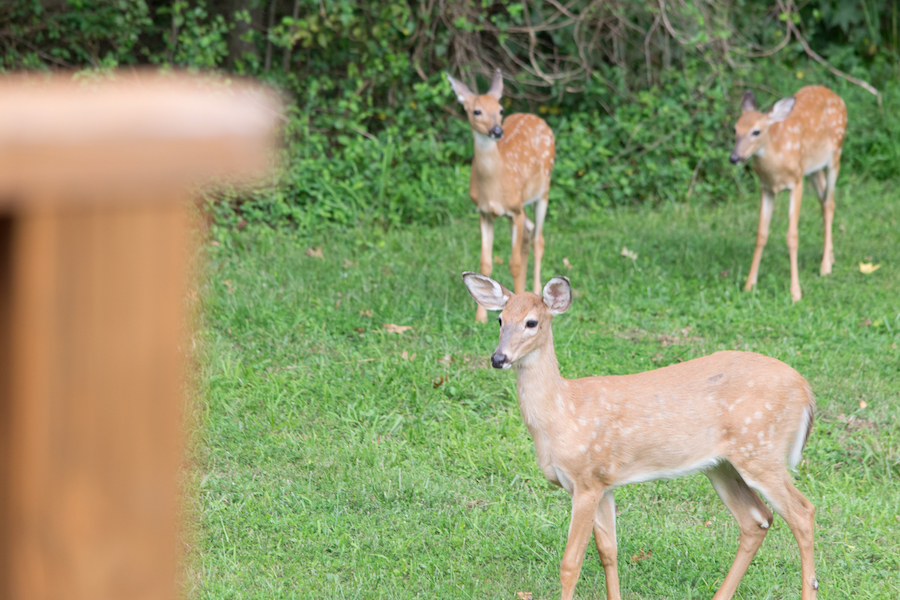
It’s time to ban road salt and make better anti-icing alternatives
 Deer like salt. I found this out during my last trip to Yosemite after a deer ran across the road and forced the person driving to tap the brakes.
Deer like salt. I found this out during my last trip to Yosemite after a deer ran across the road and forced the person driving to tap the brakes.
We slowed at every bend in the road after that, and we were surprised to see at least 10 more deer. They bounded across the highway or lingered with their heads bent to the asphalt. A huge stag with a rack of antlers stared at us unflinchingly. A doe watched our car, obviously insulted, as her fawn struggled out of the road. Something was drawing them into the road, endangering their lives and ours.
I wondered what the deer were up to, until I remembered stories that my uncle told about gigantic moose who wandered out of the woods to lick the salted roads in Maine.
Of course. They were eating salt.
“When ice is so thick and frozen that it cannot be cut with machinery, salting provides the ability to begin the breakdown of the ice,” said The Tuolumne County Community Resources Agency. “This process is very politically controversial and is used very sparingly throughout the county.”
Communities use salt to break up ice and give cars traction to drive, but the salt crystals sometimes attract deer and moose to roads, which increases their chances of being hit by cars.
“Road salt is kind of like potato chips for animals,” said Emilie Snell-Rood, an associate professor of ecology, evolution and behavior at the University of Minnesota.
Can you imagine the kind of sick trap we’re setting up for these deer?
When animals venture into roadways for salt, they’re also exposed to dangerous chemicals, such as car exhaust, spilled gas and metal shaving from brake pads.
“Approximately 15 million tons of deicing salt are used each year in the United States,” said Rena Silverman, a journalist for National Geographic. “Salt on snowy roads can reduce accidents by up to 88 percent, compared with untreated roads. But sodium chloride […] can harm aquatic life and vegetation when the ice-salt mix seeps into groundwater and streams, where it can remain for decades.”
Salt also threatens birds who ingest salt crystals, animals whose food sources and shelters become compromised and people on low-sodium diets whose drinking water has been contaminated.
“Many people assume that when you apply salt to the landscape it just gets washed away and disappears,” said Sujay Kaushal, a professor of geology at University of Minnesota Duluth. “But salt accumulates in soils and groundwater and takes decades to get flushed out.”
“The ‘freshwater salinization syndrome’ […] could be an issue for people with high blood pressure that require a low-sodium diet and patients who need kidney dialysis,” said Roni Dengler, a 2017 AAAS mass media science and engineering fellow.
Why are we still salting the roads if it’s bad for wildlife, the environment and people? Salting the roads may help prevent accidents today, but what will that cost us tomorrow? We need to ban the use of road salt and find a safe alternative — one that’s good for the environment, practical and affordable.
Thankfully, researchers and local governments in some places have already turned to salt alternatives.
Two counties in California use salt brine, which is reportedly more effective and better for the environment. A place in Wisconsin uses cheese brine — that’s right, Wisconsinites are using cheese — and Alaska and Colorado have switched from salt to magnesium chloride.
Weird anti-icing solutions abound.
“Unconventional sources of salt brines, such as pickle juice, beet juice, potato and cheese byproducts, are decreasing costs, lowering environmental impacts and are effective at temperatures well below zero,” said AccuWeather.
Even so, some researchers claim that salt alternatives will not solve the problem.
“The answer isn’t really in alternative salts but in less salt,” said Roy Rea, a biology and forestry instructor at the University of Northern British Columbia.
When communities salt in smaller amounts before a storm, most of the salt gets washed away, and less salt on the road means less salt in the waterways.
It’s a relief to know that we’re working toward a resolution and finding creative ways to approach the environmental issues surrounding the road salt problem. Whatever we do, I hope that we do it fast — and that the deer find it less tasty.
Written by: Jess Driver — jmdriver@ucdavis.edu
Disclaimer: The views and opinions expressed by individual columnists belong to the columnists alone and do not necessarily indicate the views and opinions held by The California Aggie.



